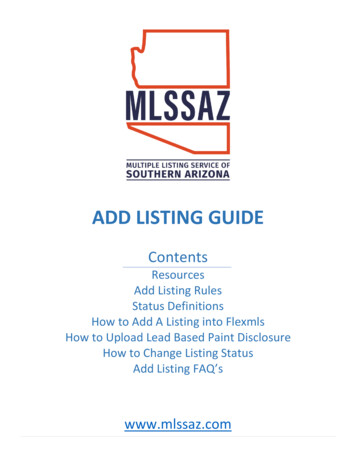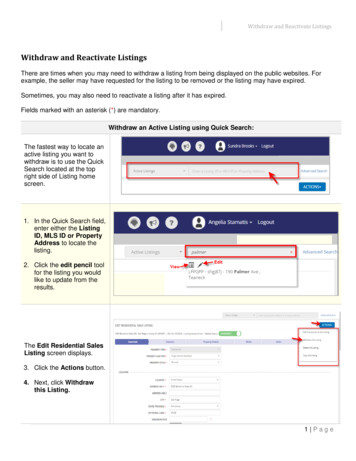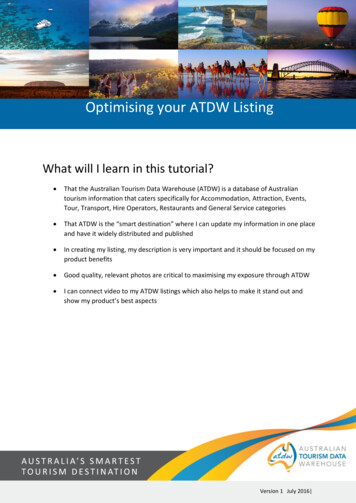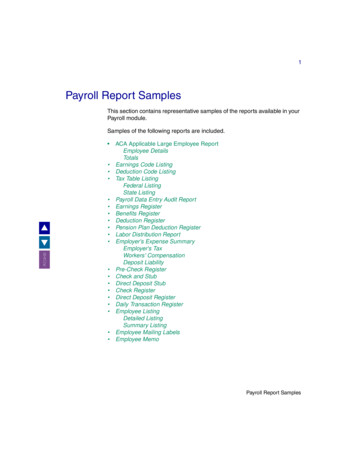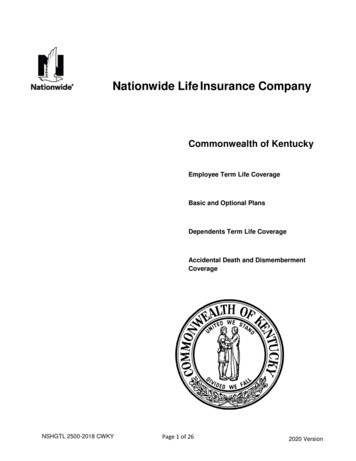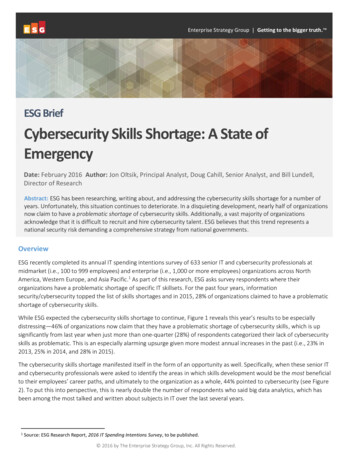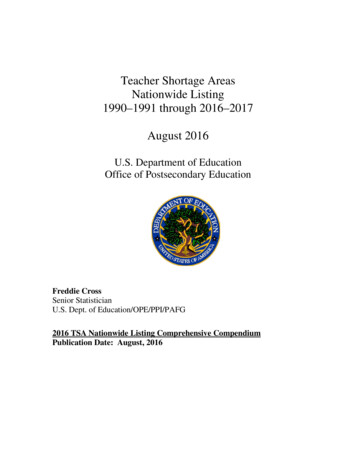
Transcription
Teacher Shortage AreasNationwide Listing1990–1991 through 2016–2017August 2016U.S. Department of EducationOffice of Postsecondary EducationFreddie CrossSenior StatisticianU.S. Dept. of Education/OPE/PPI/PAFG2016 TSA Nationwide Listing Comprehensive CompendiumPublication Date: August, 2016
TEACHER SHORTAGE AREA NATIONWIDE LISTThe nationwide Teacher Shortage Area (TSA) lists for the 2016–2017 school year havebeen completed. This report shows the nation’s teacher shortage areas by State. It is alsoavailable on the U.S. Department of Education’s Web site at the following /pol/tsa.docThe Federal designation of teacher shortage areas in each State is relevant to thefollowing provisions relating to the Federal student financial aid programs: Under 34 CFR 682.210(q) a borrower who teaches in one of these areas and whowas a new borrower in the Federal Stafford Loan Program or the FederalSupplemental Loans for Students program on or after July 1, 1987 but beforeJuly 1, 1993 qualifies for deferment of loan repayment for up to three years whilethe borrower is in repayment. A new borrower is a borrower who did not havean outstanding balance on a Federal Stafford Loan, a Federal SLS loan or aFederal PLUS loan for a period of enrollment beginning prior to July 1, 1987 or aFederal Consolidation Loan that repaid a loan made before July 1, 1987 and for aperiod of enrollment beginning before July 1, 1987. Federal Direct Loanborrowers who owed an outstanding balance on a Federal Stafford Loan or aFederal SLS loan before July 1, 1993 may also qualify for this deferment on theirloan under 34 CFR 685.204(j).; Under 34 CFR 674.53(c) Federal Perkins Loan borrowers who are full–timeteachers of mathematics, science, foreign languages, bilingual education or anyother field of expertise where the State educational agency determined thereis a shortage of qualified teachers to qualify for cancellation of up to 100percent of their Perkins loan; and Under 34 CFR 686.12 a grant recipient may fulfill his or her teaching obligationunder the Teacher Education Assistance for College and Higher Education(TEACH) Grant Program by teaching in one of these areas.Federal student loan borrowers who have general questions concerning their loan(s),including the teacher shortage area deferment, can contact the Federal Student AidInformation Center at 1–800–4FED–AID.1
Please note: This publication of approved teacher shortage areas is a reference documentthat is intended to serve three primary purposes:1. Notify the nation that States and schools may potentially hire academicadministrators, licensed teachers, and other educators and school faculty ofspecific disciplines/subject areas, grade levels, and/or geographic regions.2. Serve as a useful resource for recent graduates of Schools of Education andtrained, experienced teaching professionals aspiring to serve school districts withshortages about potential opportunity areas in each State’s and territory’s PreKindergarten through Grade 12 classrooms.3. Serve as a useful resource in the process of advising Federal student financial aidrecipients of the potential to reduce, defer, or discharge student loan repaymentsby teaching in certain areas.Please note, thus, the annual Teacher Shortage Nationwide List is not an “employmentdirectory” for current and prospective educators aspiring to be hired by specific State andlocal school districts. It is not a list of “job postings” in the education fields.A large number of variables that are not addressed in this report will have a direct impacton actual hiring within State and local schools districts (as well as their respectiveelementary, middle, and/or high schools). For example, these entities may not currentlyhave the necessary funds, approvals/authorizations, and other provisions to fill thevacancies in particular academic disciplines and/or locations. In addition, this report doesnot include particular administrative position classifications (e.g., counselor, mediaspecialist, principal, and other roles).The Department appreciates the efforts and patience of the Chief State School Officers(CSSOs) and State representatives who provided the required data (and supportingdocumentation and assurances) for updating this text. We welcome comments orsuggestions about this listing and would appreciate hearing from individuals. Pleasedirect your comments or suggestions to:Freddie CrossSenior StatisticianOffice of Postsecondary EducationU.S. Department of Education400 Maryland Ave, SW 6W241Washington, D.C. 20202(202) 453–7224Freddie.cross@ed.govThis data collection is authorized under:OMB No. 1840–0595Expires: 12/31/20162
General NotesNumbers in parenthesis refer to grade level, unless age is specified. For example, “(4–12)” refers to Grades 4 through 12.For purposes of this Report, the term “State” refers to the 50 States, the District ofColumbia (DC), Puerto Rico, Guam, American Samoa, the U.S. Virgin Islands, theCommonwealth of the Northern Mariana Islands and the Freely Associated States(the Republic of the Marshall Islands, the Federated States of Micronesia and theRepublic of Palau).No TSA proposal submitted–This indicates the State chose not to submit a TSAproposal for consideration.No TSAs approved–This indicates a TSA proposal was submitted, but adequateinformation was not provided.State declared no TSAs exist–This indicates the State sent a letter indicating that noshortage areas exist for the school year indicated.Teacher Shortage Areas: According to 34 CFR 682.210(q)(8)(vii), “teacher shortagearea” means “an area of specific grade, subject matter or discipline classification, or ageographic area in which the Secretary determines that there is an inadequate supply ofelementary or secondary school teachers.”The Department encourages each State Chief State School officer (CSSO) office todetermine its State’s proposed teacher shortage areas based on the prescribedmethodology and other requirements in 34 CFR 682.210(q)(6)(iii). For the Departmentto consider the State specified areas as teacher shortage areas the percentage of theState’s proposed teacher shortage areas 1 may not exceed the automatic designated limitof five percent of all unduplicated full-time equivalent (FTE) elementary and secondaryteaching positions in the State.However, under 34 CFR 682.210(q)(6)(iv), if the total number of proposed designatedFTE elementary and secondary teaching positions in the State exceeds five percent of thetotal number of elementary and secondary FTE teaching positions the State’s CSSO maysubmit, with the list of proposed areas, supporting documentation showing the methodsused for identifying the specific shortage areas, and an explanation of the reasons why theSecretary should designate all of the proposed areas as teacher shortage areas.1Calculation –– Teacher shortage areas as a percentage of the FTE teaching positions for all teachers in theState. A combination of the following unduplicated FTEs may be used to calculate teaching shortage areaFTEs and the percentage of total FTEs: (a) teaching positions that are unfilled; (b) teaching positions thatare filled by teachers who are certified by irregular, provisional, temporary, or emergency certification; and(c) teaching positions that are filled by teachers who are certified, but who are teaching in academic subjectareas other than their area of preparation.3
ABBREVIATIONS (Examples)“BIA”–Bureau of Indian Affairs“BLE”–Bilingual Language Education“ESL”–English as a Second Language“ESOL”–English to Speakers of Other Languages“HS”–High School“K”–Kindergarten“MS”–Middle School“N”–Nursery“Pre-K” (or “PK”)–Pre-Kindergarten“ROTC”–Reserve Officers’ Training Corps“TESOL”–Teachers of English to Speakers of Other Languages“TSA”–Teacher Shortage Area4
Student Information–Loan Forgiveness and/or DefermentDepending on the type of loan(s) a student borrower has, there are certain conditions theyneed to meet in order to qualify for forgiveness and/or deferment. Borrowers shouldcontact the holder of the loan(s) to find out whether the loans may qualify for forgivenessand/or deferment.To apply for loan forgiveness or deferment, borrowers will need to apply through theholders of loans. Loan holders have the necessary forms needed to apply. A FFEL loanborrower should check their current bill or the National Student Loan Data System(NSLDS) for the name and contact information of the current holder or servicer of theirloan. Borrowers may also be able to get information from the State education agency inthe State where they are teaching.Direct Loan borrowers should contact the U.S. Department of Education's Direct LoanServicing Center at 1–800–557–7394.Federal Perkins Loan borrowers should contact the school where they received thePerkins Loan.The following Web site provides additional information regarding thecancellation/discharge and deferment provisions for the Federal student loan programs:https://studentaid.ed.gov/homeThe following Web sites have the annually published Low-Income School 5
Paul Douglas Teacher Scholarship ProgramStudents who received a scholarship under the Paul Douglas Teacher ScholarshipProgram (formerly the Congressional Teacher Scholarship Program) are generallyrequired to teach for two years for every year of scholarship assistance received.However, if they are teaching in a Federally approved teacher shortage area, they arerequired to teach only one year for each year of scholarship assistance received.No new funding for individual scholarships has been authorized since the beginning ofthe 1996–1997 year. However, former scholarship recipients who have not fulfilled thescholarship agreement must continue to do so.A Federally approved teacher shortage area is a State region with a shortage ofelementary or secondary school teachers, or a grade level, subject-matter, or disciplineclassification in which there is a Statewide shortage of elementary or secondary schoolteachers. These areas must be identified by the State education agency and approved bythe Department. The current and prior Federally designated teacher shortage areasare indicated in this publication.For scholarship recipients who teach in a shortage area one year that is not designated assuch the next year, they will still be eligible for the teaching reduction if they provide theapplicable State office with the appropriate forms certifying that they are continuing toteach in the area for which the original “teacher cancellation” was received.6
TEACH Grant ProgramThe Teacher Education Assistance for College and Higher Education (TEACH) GrantProgram provides grants of up to 4,000 per year to students who agree to serve as ahighly-qualified full-time teacher in a high-need field in a public or private elementary orsecondary school that serves students from low-income families. A TEACH Grantrecipient must teach for at least four academic years within eight years of completing theprogram of study for which the TEACH Grant was received.If a TEACH Grant recipient fails to complete the service requirement, the total amount ofTEACH Grant funds received will be converted to a William D. Ford Federal DirectUnsubsidized Loan.Institutional participation in the TEACH Grant Program is optional, not required. If aninstitution opts to participate in the TEACH Grant Program, the institution has theauthority to determine which of its programs meet the requirements to be TEACH Granteligible. An institution may designate only certain programs as TEACH Granteligible and not designate others, even though programs may prepare a student toteach in a high-need field. In order to be eligible to receive a TEACH Grant, a studentmust be enrolled in a TEACH Grant-eligible program and be otherwise eligible.Current high–need fields (in schools that serve low–income students) are: Bilingual Education and English Language Acquisition Foreign Language Mathematics Reading Specialist Science Special Education Other Identified Teacher Shortage Areas (not geographic areas) as of the timerecipients receive the grant or as of the time they begin teaching in that field. The“other identified teacher shortage areas” are listed in this publication.Additional information about the student eligibility requirements for the TEACH GrantProgram may be found in a Fact Sheet at the following Web /siteresources/4807Teach FactSheet v3.pdfA list of higher education institutions currently participating in the TEACH GrantProgram may be found at the following Web ts/english/TEACH.jspThe following Web site has the annually published Low-Income School IPubSchoolSearch.jsp7
TABLE OF CONTENTSNEW YORK . 118NORTH CAROLINA . 123NORTH DAKOTA . 124OHIO . 128OKLAHOMA . 130OREGON . 132PENNSYLVANIA . 133RHODE ISLAND . 138SOUTH CAROLINA . 142SOUTH DAKOTA . 146TENNESSEE . 148TEXAS . 150UTAH. 152VERMONT . 154VIRGINIA . 157WASHINGTON. 161WEST VIRGINIA . 162WISCONSIN . 174WYOMING . 176AMERICAN SAMOA . 178GUAM . 178NORTHERN MARIANA ISLANDS . 180PALAU. 181PUERTO RICO . 182U.S. VIRGIN ISLANDS . 182Department of Defense EducationActivities (DoDEA) . 183GENERAL NOTES. 3ABBREVIATIONS (EXAMPLES) . 4STUDENT INFORMATION–LOANFORGIVENESS AND/OR DEFERMENT . 5PAUL DOUGLAS TEACHERSCHOLARSHIP PROGRAM . 6TEACH GRANT PROGRAM . 7TABLE OF CONTENTS . 8ALABAMA. 9ALASKA. 11ARIZONA . 11ARKANSAS . 19CALIFORNIA . 23COLORADO . 25CONNECTICUT . 26DELAWARE . 29DISTRICT OF COLUMBIA. 31FLORIDA . 33GEORGIA . 34HAWAI’I . 41IDAHO . 43ILLINOIS . 48INDIANA . 52IOWA . 54KANSAS. 60KENTUCKY. 62LOUISIANA . 65MAINE. 66MARYLAND . 69MASSACHUSETTS . 75MICHIGAN . 77MINNESOTA . 83MISSISSIPPI . 87MISSOURI . 87MONTANA . 94NEBRASKA . 96NEVADA . 99NEW HAMPSHIRE . 106NEW JERSEY . 111NEW MEXICO . 1178
ALABAMA2010–20111990–1991 through 1998–1999Agri–Science (Grades 7–12)Art (Grades 7–12)Band (Grades 7–12)English/Language Arts (Grades 7–12)Family Consumer Science (Grades 9–12)Foreign Languages (Grades 7–12)Guidance and Counseling (Grades 7–12)Health Occupation (Grades 7–12)History/Social Science (Grades 7–12)Mathematics (Grades 7–12)Music (Grades 7–12)Science (Grades 7–12)Special Education (K–Grade 12)AutismGiftedLearning DisabledMentally g ImpairedSpecial Education (K–Grade 12)Emotionally ConflictedLearning DisabledMental Retardation1999–2000Special EducationEmotional DisturbanceMental RetardationSpecific Learning DisabilitiesSpeech and Language Impairment2000–2001 through 2003–2004No TSA proposal submitted2004–2005 through 2009–2010ArtBandEnglish/Language Arts (K–Grade 12)Family Consumer Science (Grades 9–12)Foreign Languages (Grades 7–12)Guidance and Counseling (Grades 7–12)History/Social Science (Grades 7–12)Mathematics (Grades 7–12)MusicScience (Grades 7–12)Special EducationAutism (Grades 7–12)Gifted (Grades 6–12)Learning Disabled (Grades 7–12)Mentally Retarded (Grades 7–12)Multi–Handicapped (Grades 7–12)SpeechVisually–Hearing Impaired2011–2012ArtBandEnglish/Language Arts (Grades 7–12)Family Consumer Science (Grades 9–12)Foreign Languages (Grades 7–12)Guidance and Counseling (Grades 7–12)History/Social Science (Grades 7–12)Mathematics (Grades 7–12)MusicScience (Grades 7–12)Special EducationAutism (Grades 7–12)Gifted (Grades 6–12)Learning Disabled (Grades 7–12)Mentally Retarded (Grades 7–12)Multi–Handicapped (Grades 7–12)SpeechVisually–Hearing Impaired9
2012–20132014–2015Statewide Academic Disciplines or SubjectMatterStatewide Academic Disciplines or SubjectMatterArts: Art, Band, and Music (All Grade Levels)English/Language Arts (Grades 7–12)Family Consumer Science (Grades 9–12)Foreign Languages (Grades 7–12)Guidance and Counseling (Grades 7–12)History/Social Sciences (Grades 7–12)Mathematics (Grades 7–12)Science (Grades 7–12)Special EducationAutism (Grades 7–12)Gifted (Grades 6 –12)Learning Disabled (Grades 7–12)Mentally Retarded (Grades 7–12)Multi–Handicapped (Grades 7–12)Speech (All Grade Levels)Visually–Hearing Impaired (All GradeLevels)Foreign Languages (Grades 6–12)Mathematics (Grades 6–12)Science (Grades 6–12)Special EducationAutism (K–Grade 12)Gifted (K–Grade 12)Learning Disabled (K–Grade 12)Mentally Retarded (K–Grade 12)Multi–Handicapped (K–Grade 12)Speech (K–Grade 12)2015–2016Statewide Academic Disciplines or SubjectMatterAgri–Science (Grades 6–12)Arts: Art, Band, and Music (Grades 6–12)Career TechnologiesEnglish/Language ArtsFamily Consumer ScienceGuidance and CounselingHealth OccupationsForeign Languages (Grades 6–12)History/Social Sciences (Grades 6–12)Mathematics (Grades 6–12)Science (Grades 6–12)Special EducationAutism (K–Grade 12)Gifted (K–Grade 12)Learning Disabled (K–Grade 12)Mentally Retarded (K–Grade 12)Multi–Handicapped (K–Grade 12)Speech (K–Grade 12)2013–2014Statewide Academic Disciplines or SubjectMatterAgri–Science (Grades 6–12)Arts: Art, Band, and Music (Grades 6–12)English/Language Arts (Grades 6–12)Family Consumer Science (Grades 9–12)Foreign Languages (Grades 6–12)Guidance and Counseling (Grades 6–12)Health Occupation (Grades 6–12)History/Social Sciences (Grades 6–12)Mathematics (Grades 6–12)Science (Grades 6–12)Special EducationAutism (K–Grade 12)Gifted (K–Grade 12)Learning Disabled (K–Grade 12)Mentally Retarded (K–Grade 12)Multi–Handicapped (K–Grade 12)Speech (K–Grade 12)Visually–Hearing Impaired (K–Grade 12)10
2016–20172000–2001 through 2003–2004Statewide Academic Disciplines or SubjectMatterNo TSA proposal submitted2004–2005Arts: Art, Band, and Music (Grades 6–12)Career Technologies (Grades 6–12)English/Language Arts (Grades 6–12)Foreign Languages (Grades 6–12)Mathematics (Grades 6–12)Science (Grades 6–12)Special EducationAutism (K–Grade 12)Gifted (K–Grade 12)Learning Disabled (K–Grade 12)Mentally Retarded (K–Grade 12)Multi–Handicapped (K–Grade 12)Speech (K–Grade 12)Visually–Hearing Impaired (K–Grade 12)State declared no TSAs exist2005–2006 through 2011–2012MathScienceSpecial Education2012–2013 through 2014–2015Statewide Academic Disciplines or SubjectMatter1990–1991 through 1994–1995MathematicsScienceSocial StudiesSpecial EducationState declared no TSAs exist2015–2016 and 2016–20171995–1996 through 1997–1998Statewide Academic Disciplines or SubjectMatterALASKASchool PsychologySpecial EducationSpeech PathologyEnglish/Language ArtsMathematicsScienceSocial StudiesSpecial EducationEducation1998–1999AdministrativeSchool PsychologySpecial EducationSpeech PathologyARIZONA1990–1991 and 1991–19921999–2000Geographic Shortage AreasAdministrativeMathematicsSchool PsychologySpecial EducationSpeech PathologyAguila ElementaryAsh Creek ElementaryCedar UnifiedChinle UnifiedCochise Special Education Coop11
Wellton ElementaryWilson ElementaryGadsden ElementaryHolbrook UnifiedIndian Oasis UnifiedKayenta UnifiedMaricopa UnifiedNavajo Special ServicesNogales UnifiedPage UnifiedPeach Springs ElementaryPinon UnifiedRed Mesa UnifiedSalome Consolidated ElementarySan Carlos UnifiedSanders UnifiedTolleson ElementaryTuba City UnifiedWellton ElementaryWilson ElementaryYarnell Elementary1993–1994Geographic Shortage AreasApacheCedar UnifiedChinle UnifiedCochise County Educational ServiceGanado UnifiedGreenlee County AccommodationHolbrook UnifiedHyder ElementaryIndian Oasis–Baboquivari UnifiedKayenta UnifiedKirklandLaveenMaricopa Special Services ConsortiumMcNaryMcNealNacoPage UnifiedPalo VerdeParker UnifiedPatagonia Union High SchoolPeach SpringsPinon UnifiedRed Mesa UnifiedRed Rock SchoolSalome Consolidated ElementarySan Carlos UnifiedSanders UnifiedSanta Cruz SchoolSanta Cruz Valley Union High SchoolTollesonTuba City UnifiedWellton ElementaryWhiteriver Unified District1992–1993Geographic Shortage AreasAguila ElementaryAsh Creek ElementaryCedar UnifiedChinle UnifiedCochise Special Education CoopHolbrook UnifiedIndian Oasis UnifiedKayenta UnifiedMcNeal ElementaryNaco ElementaryNavajo Special ServicesNogales UnifiedPage UnifiedParker UnifiedPatagonia UnifiedPeach Springs ElementaryPinon UnifiedRed Mesa UnifiedSalome Consolidated ElementarySan Carlos UnifiedSanders UnifiedTolleson ElementaryTuba City Unified1994–1995Geographic Shortage AreasAlpine ElementaryAsh Creek12
Cedar UnifiedEagleGadsdenGanado UnifiedHolbrook UnifiedHyderIndian Oasis–Baboquivari UnifiedKayenta UnifiedKirklandLaveenMcNaryMcNealNacoPage UnifiedPalo VerdePeach SpringsPhoenix ElementaryPicachoPinon UnifiedRed Mesa UnifiedSalome Consolidated ElementarySan Carlos UnifiedSanders UnifiedSanta CruzSanta Cruz Valley Union HighTollesonTuba City UnifiedWellton ElementaryWhiteriver UnifiedNogales UnifiedPage UnifiedPeach SpringsPicachoPinon UnifiedRed Mesa UnifiedRiversideSalome Consolidated ElementarySan Carlos UnifiedSanders UnifiedSomertonTollesonTuba City UnifiedValentine ElementaryWenden ElementaryWhiteriver UnifiedWilson Elementary1996–1997Geographic Shortage AreasAlpine ElementaryAntelope Union HighAsh Creek ElementaryAguila ElementaryBicentennial Union HighBouse ElementaryCedar UnifiedConcho ElementaryFort Thomas UnifiedGanado UnifiedHolbrook UnifiedIndian Oasis–Baboquivari UnifiedKayenta UnifiedLaveen ElementaryMaricopa UnifiedNogales UnifiedPage UnifiedPeach Springs ElementaryPinon UnifiedQuartzsite ElementaryRiverside ElementaryRoosevelt ElementarySalome Consolidated ElementarySan Carlos UnifiedSanders Unified1995–1996Geographic Shortage AreasAlpine ElementaryApacheAvondaleBouse ElementaryCedar UnifiedGadsdenGanado UnifiedHolbrook UnifiedKayenta UnifiedLaveenMcNealMohawk ValleyNaco13
Santa Cruz ElementarySanta Cruz Valley Union HighTolleson ElementaryTuba City UnifiedValentine ElementaryWhiteriver UnifiedYoung ElementaryHolbrook Unified DistrictHyder Elementary DistrictMaricopa City Regional Special ServicesMurphy School DistrictNogales Unified DistrictOsborne Elementary DistrictPaloma Elementary DistrictPicacho Elementary DistrictPinon Unified DistrictRoosevelt School DistrictSalome Cons. Elem. DistrictSanders Unified DistrictSan Fernando Elementary DistrictSanta Cruz School DistrictStanfield Elementary DistrictTolleson School DistrictTopock Elementary DistrictValentine Elementary DistrictWilson Elementary DistrictYarnell School District1997–1998Geographic Shortage AreasAguila ElementaryAlpine Elementary DistrictAntelope Union High School DistrictCedar Unified DistrictFowler School DistrictGanado Unified DistrictKayenta Unified DistrictLaveen School DistrictMaricopa Unified School DistrictMurphy School DistrictNogales Unified DistrictOwens Elementary School DistrictPeach Springs Unified DistrictPinon Unified DistrictQueen Creek Unified DistrictRoosevelt School DistrictSalome Consolidated ElementarySan Carlos Unified DistrictSanta Cruz School DistrictSpecial Education Accommodation DistrictTolleson School DistrictTonto Basin School DistrictTopock School DistrictWhiteriver Unified DistrictYarnell School DistrictYucca Elementary School District1999–2000Geographic Shortage AreasChinle Unified DistrictCoolidge Unified DistrictFlorence Unified DistrictGanado Unified DistrictMohave Union High School DistrictMurphy Elementary DistrictPatagonia Union High School DistrictPhoenix Elementary DistrictPinon Unified DistrictRoosevelt Elementary DistrictSalome Consolidated Elem. DistrictStanfield Elementary District2000–2001 through 2003–20041998–1999No TSA proposal submittedGeographic Shortage Areas2004–2005Blue Elementary School DistrictBuckeye Elementary DistrictCreighton Elementary DistrictFowler School DistrictForeign Languages (Grades 7–12)Mathematics (Grades 7–12)Special Education (K–Grade 12)14
MathScienceSocial StudiesPinal County (Middle Schools)English as a Second LanguageYuma County (Middle Schools)MathScience2005–2006 and 2006–2007Statewide Shortage AreasAll Core Content Areas (Grades 7–8)Arts (K–Grade 12)Civics Core Content (Grades 9–12)Economics Core Content (Grades 9–12)Foreign Language (Grades 9–12)Geography Core Content (Grades 9–12)Math (Grades 9–12)Political Science Core Content (Grades 9–12)Science (Grades 9–12)Special Education (K–Grade 12)2007–2008Geographic Shortage AreasApacheCochiseCoconinoGilaGrahamGreenleeLa PazMaricopaMohaveNavajoPimaPinalSanta CruzYavapaiYumaGeographic Shortage AreasBIA Reservation SchoolsNative American DistrictsRural AreasCounty Specific Shortage AreasApache County (Middle Schools)Language ArtsMathScienceSocial StudiesCochise County (Middle Schools)Language ArtsMathScienceCoconino County (Middle Schools)Language ArtsMathScienceGraham County (Middle Schools)MathScienceSocial StudiesLa Paz County (Middle Schools)MathMaricopa County (Middle Schools)MathScienceNavajo County (Middle Schools)Language ArtsAcademic Disciplines StatewideElementary CoreElementaryESL/BLESpecial EducationMiddle GradesGeneral ScienceLanguage Arts/ReadingMathematicsSocial ishESL/BLEForeign Language15
GeographyHistoryMathematicsScienceSpecial EducationAcademic Disciplines StatewideGeneralEarly Childhood EducationESL/BLE (K–12)Special Education (Pre-K–12)ElementaryCoreESL/BLEMusicReading SpecialistVisual ArtsSpecial EducationMiddle GradesGeneral ScienceLanguage Arts/ReadingMathematicsMusicReading SpecialistSocial StudiesVisual h ScienceEconomicsEnglishESL/BLEForeign itical Science/GovernmentReading SpecialistScienceSpecial EducationVisual ArtsAcademic Disciplines in Rural AreasElementaryMiddle GradesGeneral ScienceLanguage Arts/ReadingMathematicsSocial ishESL/BLEForeign LanguageGeographyHistoryMathematicsScienceSpecial Education2008–2009 and 2009–2010Geographic Shortage AreasApacheCochiseCoconinoGilaGrahamGreenleeLa PazMohaveNavajoPinalSanta CruzYuma2010–2011 and 2011–2012Geographic Shortage AreasApacheGila16
Severely and Profoundly DisabledVisual ArtsGrahamGreenleeMohaveNavajoPinalSanta CruzYuma2012–2013Statewide Academic Disciplines or SubjectMatterElementary Content AreasESL/BLEMathematics SpecialistMusicReading SpecialistSpecial EducationVisual Arts (Art)Middle GradesESL/BLEForeign LanguageGeneral ScienceLanguage Arts/ReadingMathematicsMathematics SpecialistMusicReading SpecialistSocial StudiesSpecial EducationVisual Arts (Art)Secondary LevelBiologyChemistryEarth ScienceEconomicsEnglishESL/BLEForeign LanguageGeneral ScienceGeographyHistoryMathematicsMusicPhysical SciencePhysicsPolitical Science/American GovernmentReading SpecialistSpecial EducationVisual Arts (Art)Academic Disciplines StatewideElementary GradesESL/BLEMusicReading SpecialistSpecial EducationCross CategoricalEarly Childhood (Including Pre-K)Emotional DisabilityLearning DisabilityMental RetardationSeverely and Profoundly DisabledVisual ArtsMiddle GradesESL/BLEGeneral ScienceMathematicsReading SpecialistSpecial EducationCross CategoricalEmotional DisabilityLearning DisabilityMental RetardationSeverely and Profoundly DisabledVisual ArtsSecondary GradesEconomicsESL/BLEGeneral ScienceGeographyMusicReading SpecialistSpecial EducationCross CategoricalEmotional DisabilityHearing ImpairmentLearning DisabilityMental Retardation17
Geographic Shortage Areas (Counties)Visual Arts (Art)Secondary LevelChemistryEarth SciencesEconomicsGeneral SciencesGeographyPhysical SciencePolitical Science/American GovernmentReading SpecialistSpecial a PazMaricopaMohaveNavajoPinalSanta CruzYavapaiYumaGeographic Shortage Areas (Counties)ApacheCo
elementary or secondary school teachers, or a grade level, subject-matter, or discipline classification in which there is a Statewide shortage of elementary or secondary school teachers. These areas must be identified by the State education agency and approved by the Department. The current and prior . Federally designated teacher shortage areas

